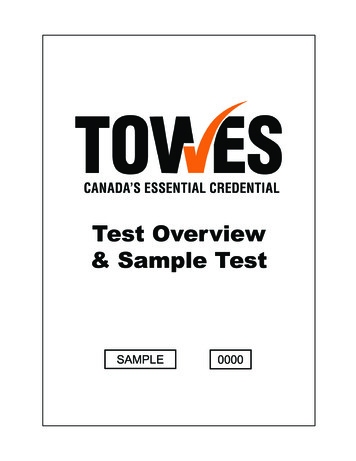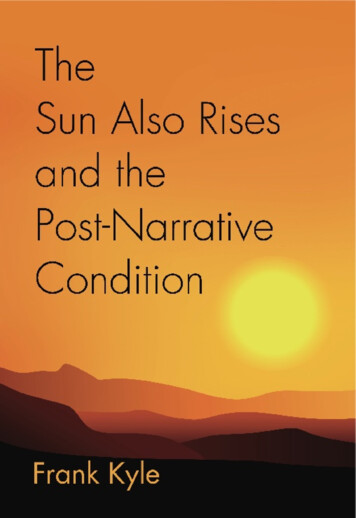
Transcription
NEGATION TEST SERIESBY
e-GMAT LLC. Unauthorized copying for commercial and competitive purposes is not allowed.Table of ContentsIntroduction . 3ARTICLE #1 What is Negation and What Are Various Sample Spaces? . 5Introduction . 5Polar opposite vs Logical opposite . 5What is Negation in CR? . 6Understanding Sample Spaces . 7Exercise Questions . 10Answer Key . 12ARTICLE #2 How Do You Negate Statements?. 14Introduction . 14How to Negate Statements. 14Step 1: Understanding the Segment . 14Step 2: Understanding the Sample Space. 14Step 3: Understand the possibilities outside the identified Sample-Space. 14Example A . 15Example B . 16Exercise Questions . 20Answer Key . 22ARTICLE #3 What is Negation Test and How to use it. 24Introduction . 24What is the Negation Test? . 24Why does the negation Test Work. 24When to use the Negation test. 25Negation test in Action: Example 1 . 26Question . 26Passage Analysis. 26Initial answer choice Evaluation . 26Choice A . 27Choice B. 28Negation test in Action: Example 2 (Official Question - Modified) . 29Question . 30Passage Analysis. 301 Page
e-GMAT LLC. Unauthorized copying for commercial and competitive purposes is not allowed.Initial answer choice evaluation . 31Choice A . 31Choice B. 32Choice C . 332 Page
e-GMAT LLC. Unauthorized copying for commercial and competitive purposes is not allowed.INTRODUCTIONA lot of students are scared of Assumption questions in the Critical Reasoning Section of theGMAT, simply because they are never really sure of the answer they are marking. The reason theyface this problem is that they do not know how to exploit a key feature of any assumption.Needless to say that this lack in their understanding can cost them gravely since Assumption,together with related questions categories (such as Evaluate, Strengthen, Weaken etc.), accounts formore than 70% of the CR questions served in the exam.Before we go any further, why don’t you try an Official Assumption argument to have a firsthandexperience of this question category:Argument: Although parapsychology is often considered a pseudoscience, it is in fact a genuinescientific enterprise, for it uses scientific methods such as controlled experiments and statistical tests ofclearly stated hypotheses to examine the questions it raises.The conclusion above is properly drawn if which of the following is assumed?(A) If a field of study can conclusively answer the questions it raises, then it is a genuine science.(B) Since parapsychology uses scientific methods, it will produce credible results.(C) Any enterprise that does not use controlled experiments and statistical tests is not genuine science.(D) Any field of study that employs scientific methods is a genuine scientific enterprise.(E) Since parapsychology raises clearly statable questions, they can be tested in controlledexperiments.What was your experience of the above question? Were you too unsure while marking the answersince you were confused between two answer choices? Did you have to re-read the passage whileevaluating the answer choices, even though you did spend appropriate amount of timeunderstanding the argument? If yes, then that means that you too are missing out on leveraging theNegation Test that exploits a central feature of an assumption - that it has to be true for theargument to hold true!3 Page
e-GMAT LLC. Unauthorized copying for commercial and competitive purposes is not allowed.To make you understand and master the concept of Negation test, we have designed this e-book.Through a step-by-step approach, we shall demonstrate how the Negation test can help you markthe correct answer to an assumption within less than 2 minutes and that too with a 100% surety.Accordingly, this e-book is divided into the following parts:What is Negation andWhat are varioussample spaces? In this article, we’llfirst understandwhat negationmeans in CriticalReasoningarguments. Next,we’ll understandthe scope ofpossibilities astatement canpresent – in otherwords, the samplespace covered by astatement.How do you negatestatements? In this article, we’llapply ourunderstandingfrom the firstarticle and seehow we can negateany givenstatement.What is Negation Test?How to leverage it tosolve CR questions? In this article, we’lluse theunderstandinggained from theprevious twoarticles tounderstand whatthe Negation Test isall about and howwe can use it toidentify the correctchoice in anAssumptionQuestion with fullconfidence.Alright, so let’s get started!4 Page
e-GMAT LLC. Unauthorized copying for commercial and competitive purposes is not allowed.ARTICLE #1 WHAT IS NEGATION AND WHAT ARE VARIOUSSAMPLE SPACES?INTRODUCTIONThe first step in understanding the Negation Test is to understand what negation means in theGMAT world. This is what we’ll cover first in this article. We’ll then understand how certain wordsplay an important role in determining the scope of the sample space covered by the statement.POLAR OPPOSITE VS LOGICAL OPPOSITENegation in the GMAT world is based on the concept of Logical Opposites. To understand whatit means, let’s contrast it with Polar Opposite.Polar Opposite: The polar opposite of a givenword/phrase/statement is the extreme oppositeof it; for instance cold is the polar opposite of hot.Logical Opposite: The logical opposite range ofa word/phrase/statement covers the spectrumof the possibilities that lie outside the arena ofthe negated word; for instance the logicalopposite range that we get by negating the word“hot” would include possibilities such asmoderately warm, lukewarm, cold etc.In all, this range includes anything andeverything that is NOT hot. Hence, the logicalopposite of “hot” is “not hot”.Below is a table that gives a few more examples to illustrate the difference between polar andlogical opposites of a word.WordBitterSummerLogical OppositesNot bitter: sour, sweet etc.Not summer: spring, winter,autumn etc.Polar Oppositesweetwinter5 Page
e-GMAT LLC. Unauthorized copying for commercial and competitive purposes is not allowed.WHAT IS NEGATION IN CR?Now that you have understood the concept of Logical Opposite, let’s see how we use the same tonegate statements in CR. Let us take a couple of examples:Statement: The soup is hot.Negation: The soup is NOT hot.Meaning of the negated statement: We don’t know whether the soup is cold, moderatelywarm or lukewarm. All that we know is that it is definitely not hot.Statement: Michael plays basketballNegation: Michael does NOT play basketball.Meaning of the negated statement: We don’t know whether Michael plays any othergame. All that we know is that he definitely doesn’t play basketball.Easy, isn’t it? Let’s now look at another example.Statement: Isabelle’s hair is black.What will be the negation of the above statement?a. Isabelle’s hair is white.b. Isabelle’s hair is not black.Observe that (a) is the polar opposite of the given statement. With (a), you miss out on a lotof other possibilities; for instance, her hair could be neither black nor white - it could be redor brown. These possibilities are accounted for in the Logical Opposite of the statement,which in this case is: Isabelle’s hair is not black. (It is not necessary to specify the actualcolor. )Meaning of the negated statement: We don’t know whether Isabelle’s hair is white or redor brown or some other color. All that we know for sure is that Isabelle’s hair is NOT black.In each of the given examples, we’re talking about only one person. So it is very easy for us to writedown the negated statement. Let’s now increase the difficulty level a bit.Consider the following statement.Statement: All tall boys have black hair.Which of the following statements is/are the correct negation(s) for the above statement?6 Page
e-GMAT LLC. Unauthorized copying for commercial and competitive purposes is not allowed.a.b.c.d.e.Some tall boys have black hair.Not all tall boys have black hair.None of the tall boys have black hair.No boy has black hair.Most of the tall boys have black hair.Only choice (b) is the correct negation of the given statement. To understand why that is the case,we need to understand the concept of Sample Spaces. Let’s move to the same. UNDERSTANDING SAMPLE SPACESThe next step in understanding the concept of negation in Critical Reasoning is to understandexactly who/what the statement is talking about, i.e. the segment the statement talks about, andhow this segment is affected by the sample space covered by the statement. This sample space isusually defined by various group markers such as: all, most, some, none etc.Let’s take a deeper look at these two aspects:Understanding the Segment:In the above example, the statement talks about a particular segment of population – All tall boyshave black hair. So we need to consider the possibilities pertinent only to tall boys. We are notconcerned with all boys, a group that includes short boys as well, or girls. ONLY tall boys arewithin the scope of the statement. This is the segment the statement talks about. Other segmentsare outside the scope of the argument and hence statements related to them are most likely not thecorrect assumptions.Understanding the Sample Space:Once you understand the segment being talked about, understand the sample space covered by thestatement. Group-markers such as all, none, some, most, etc. define this sample space for thestatement.Let’s say there are 100 tall boys (100 being a placeholder for “All” the elements in the segment).With this supposition, here is the sample space each group-marker covers:Possibilities for 100 tall boysS No.TermPossibilities it coversaNo/None0 tall boys out of 100 have black hair. (Only one possibility)bLess than 50%0 to 49 tall boys have black hair.cUp to 50%0 to 50 tall boys have black hair.dHalf (50%)50 tall boys out of 100 have black hair. (Only one possibility)eMost51 to 100 tall boys have black hair.7 Page
e-GMAT LLC. Unauthorized copying for commercial and competitive purposes is not allowed.fSome1 to 100 tall boys has black hair. (including both 1 and 100).Note that “some” does NOT include 0gNot All0 to 99 tall boys have black hair. (Notice how Not All isdifferent from Some)hAllAll the 100 tall boys have black hair. (Only one possibility)It is helpful to think of these sample spaces in terms of the possibilities they represent. Thesepossibilities can be represented on a straight line that denotes all the possibilities in the identifiedsegment - we call this line the Possibility Line.Now, in the current example, we are concerned with the segment of tall boys. This segment consistsof 100 tall boys. Since the Possibility Line will denote each and every possibility in this segment, wecan diagrammatically represent the above group markers on it in the following ways:Diagram#1 shows the possibilities related to group markers none, some, not all, half, and all.Diagram#2 shows the possibilities related to group markers none, less than half, up to half, half, most, and all.8 Page
e-GMAT LLC. Unauthorized copying for commercial and competitive purposes is not allowed.Note: For the sake of clear understanding, the above group markers have been represented on two different PossibilityLines - you can represent them on a single Possibility Line as well.As you can see in the above diagrams, the statement All tall boys have black hair covers only onepossibility point - not 99, not 98, not 14, but a point denoting the possibility that all 100 of themhave black hair. Therefore, its logical negation should account for anything and everything that isNOT 100/ALL (0-99 tall boys).We will explore the concept of negating a statement in more detail in the next article, but before wemove on to that, try your hand at solving the exercise questions given in this article.Good Luck! 9 Page
e-GMAT LLC. Unauthorized copying for commercial and competitive purposes is not allowed.EXERCISE QUESTIONSI.Assume that you’re dealing with a segment of 100 people. Following are the number ofpeople from this set who do a particular job, job X. For each statement below,determine which all groups can it fall under; for instance, the statement 0 people do Xfalls under Group A. None 0, Group C. Not more than half 0-50, and Group E. Not all 0-99.A.B.C.D.E.F.II.i.Only 1 person does X.ii.Only 50 people do X.iii.Only 70 people do X.iv.100 people do X.NoneSomeNot more than halfMostNot allAllIn the following table, map the elements of the first column to their exact matches in thesecond columnGroup markerSomeUp to halfMostNot allIII.Complete possibility range0 - 990- 4950 - 1001- 99For each of the given statements, choose the correct negation form(s) from the optionstatements.1. Given statement: The room is dark.a. The room is bright.b. The room is not bright.c. The room is anything but bright.d. The room is anything but dark.e. The room is not dark.10 P a g e
e-GMAT LLC. Unauthorized copying for commercial and competitive purposes is not allowed.2. Given statement: The per-minute charge of a call made from a landline is higherthan the per-minute call charge made from a cell phone.a. The per-minute charge of a call made from a landline is lower than the perminute call charge made from a cell phone.b. The per-minute charge of a call made from a landline is low.c. The per-minute charge of a call made from a landline is higher than the perminute call charge made from a cell phone.d. The per-minute charge of a call not made from a landline is higher than theper-minute call charge made from a cell phone.e. The per-minute charge of a call made from a cell phone is high.f. The per-minute charge of a call made from a landline is not higher than theper-minute call charge made from a cell phone.3. Given statement: The buildings in Oakville are stronger than the buildings inCottonville.a. The buildings in Oakville are as weak as the buildings in Cottonville.b. The buildings not in Oakville are not stronger than the buildings inCottonville.c. The buildings in Oakville are weaker than the buildings in Cottonville.d. The buildings in Oakville are not as strong as the buildings in Cottonville.e. The buildings in Oakville are not stronger than the buildings in Cottonville.f. The buildings not in Oakville are not as strong as the buildings in Cottonville.g. The buildings in Oakville are as strong as or weaker than the buildings inCottonville.11 P a g e
e-GMAT LLC. Unauthorized copying for commercial and competitive purposes is not allowed.ANSWER KEYQuestion I.i.ii.iii.iv.Only 1 person does X falls under the Groups B, C, EOnly 50 people do X falls under the Groups B, C, EOnly 70 people do X falls under the Groups B, D, E100 people do X falls under the Groups B, D, FQuestion II – Not All: 0 to 99Question III:1. d, e12 P a g e
e-GMAT LLC. Unauthorized copying for commercial and competitive purposes is not allowed.2. f3. e, g13 P a g e
e-GMAT LLC. Unauthorized copying for commercial and competitive purposes is not allowed.ARTICLE #2 HOW DO YOU NEGATE STATEMENTS?INTRODUCTIONIn order to negate any statement in CR, you should be familiar with the concept of logical negationand representing sample spaces on the Possibility Line. We cover all of this in our first article in theNegation Test Series: What is Negation and What are Various Sample Spaces. In thisarticle, we will apply that understanding to master the negation of any given statement. Rightthen Let’s get started!HOW TO NEGATE STATEMENTSBy this time, you should be somewhat comfortable with the concept of Possibility Line andrepresenting various sample spaces on it. Let’s follow a step-by-step approach to see how thisunderstanding can help you negate statements easily.STEP 1: UNDERSTANDING THE SEGMENTThe first step in negating a statement is understanding the segment the statement talks about. Howdo we do that? We simply understand about whom/what is the information given; for instance, ifthe statement says Most basket-ball players are more than six feet tall, then our segment is justbasketball players and not any other kind of players - the statement gives information ONLY aboutbasket-ball players.STEP 2: UNDERSTANDING THE SAMPLE SPACEThe second step in negating a statement is understanding the sample space the statement givesinformation about. Now, you know that typically group-markers such as some, most, none etc.determine the sample space for the statement. Accordingly, in the current example, the samplespace would be the range covered by the group marker “Most” 50%. This sample space isbasically the point/range of possibilities covered by the statement on the Possibility Line.Accordingly, let’s represent it on the Possibility Line:STEP 3: UNDERSTAND THE POSSIBILITIES OUTSIDE THE IDENTIFIED SAMPLE-SPACEThis is the third and the final step in negating a statement. On the Possibility Line, determine thearea that is NOT covered by the sample space/range of possibilities covered by the given statement.14 P a g e
e-GMAT LLC. Unauthorized copying for commercial and competitive purposes is not allowed.So, in the current example, the area that lies outside the possibilities covered by Most is Up to 50%.This is it! This is the negated space, using which we’ll create the negated statement.*Negated space possibilities not covered by the original sample spaceSo far so good. But how do you write this down in the form of the negated statement? It is verysimple. To derive the negated statement, you just need to replace the original group marker inthe original statement, “Most” in this case, by the negated space. Let’s do this together.Original Statement: Most basket-ball player are more than six feet tall.Negated Statement: Up to 50% of basket-ball players are more than six feet tall.Simple, wasn’t it? Let’s apply the process to some more example statements.EXAMPLE AOriginal Statement: Some farmers who live in India have adopted modern techniques in farming.Step 1 Understanding the Segment: The statement talks about a category of farmers: farmersWHO live in India. Therefore, this is our segment.Step 2 Understanding the Sample-Space: The group marker present in the statement is some.Therefore, the range of possibilities this statement talks about is 1- 100. Let’s represent it on thePossibility Line:15 P a g e
e-GMAT LLC. Unauthorized copying for commercial and competitive purposes is not allowed.Step 3 Understand the possibilities OUTSIDE the sample space: As you can see in the abovesection, the sample space covered by some is 1-100. Therefore, we are left with only one possibilityon the Possibility Line that is OUTSIDE this space – the possibility of none/no or 0 farmers who livein India. This is indeed the negated space. Let’s see it on the Possibility Line:Let’s now deduce the negated statement by replacing the original group-marker by the negatedspace:Original Statement: Some farmers who live in India have adopted modern techniques in farming.Negated Statement: None of the farmers who live in India have adopted modern techniques infarming.EXAMPLE BLet’s take another example, and this time we’ll evaluate some given statements to see which one fitsthe bill of the negated statement.Original Statement: Every individual who has taken a loan will say that EMIs are a headache.Options for negated statements:A.B.C.D.E.Not every individual who hasn’t taken a loan will say that EMIs are a headache.Only some individuals who have taken a loan will say that EMIs are a headache.No individual who has taken a loan will say that EMIs are a headache.At least one individual who has taken a loan will say that EMIs are a headache.Not every individual who has taken a loan will say that EMIs are a headache.Step 1 Understanding the Segment: The statement talks about a category of individuals:individuals WHO have taken some loan or the other.16 P a g e
e-GMAT LLC. Unauthorized copying for commercial and competitive purposes is not allowed.Step 2 Understanding the Sample-Space: The group marker present in the given statement isEvery. Now every individual means the same as all individuals. Accordingly, let’s represent it on thePossibility Line:Step 3 Understand the possibilities OUTSIDE the sample space: As you can see in the abovesection, all represents a single possibility point where each and every individual who has taken aloan will say that EMIs are a headache. So, if this segment contains 100 such individuals, then allrepresents the point at which all 100 will say that EMIs are a headache. Accordingly, anything thatis outside this possibility point falls under the negated space. Now what is this negated space?Think about it. If we start from 0, then up till what point we do not reach all or 100? It is 99, right?So the negated space will cover the range 0-99. We can represent this on the Possibility Line in thefollowing way:Let’s now deduce the negated statement by replacing the original group-marker by the negatedspace:Original Statement: Every individual who has taken a loan will say that EMIs are a headache.Negated Statement: Not all individuals who have taken a loan will say that EMIs are a headache.Now that we know what the negated statement is, evaluating the given options should be acakewalk. So, let’s get cracking!Answer Choice ExplanationA.Not every individual who hasn’t taken a loan will say that EMIs are a headache.Incorrect – Wrong Segment17 P a g e
e-GMAT LLC. Unauthorized copying for commercial and competitive purposes is not allowed.This choice talks about individuals who have NOT taken a loan. We don’t need to consider itany further.B.Only some individuals who have taken a loan will say that EMIs are a headache.Incorrect: The space covered by the option overlaps with the sample space of the given statement.Therefore, this option fails to provide the right negated space. Remember, the negated spacecontains only the possibilities OUTSIDE the original sample space.C.No individual who has taken a loan will say that EMIs are a headache.Incorrect: The space covered by the option doesn’t include all the possibilities that lie outside theoriginal sample-space. Remember, the logical negation of a statement should account for allthe possibilities lying outside the sample space of the given statement. Therefore, this optioncannot be the logical negation of the given statement.D.At least one individual who has taken a loan will say that EMIs are a headache.Incorrect: This is essentially the same as Option B, since saying that at least 1 person does Xmeans the same as saying some people do X. Think about it! At least one person did X means thatwe know for sure that 1 out of the given segment definitely did X – the number could be more; itcould be even all, but we know for sure that at least one person was involved. This gives us thesame sample space as some (1-100). Therefore, this option cannot be the logical negation of thegiven statement.E.Not every individual who has taken a loan will say that EMIs are a headache.18 P a g e
e-GMAT LLC. Unauthorized copying for commercial and competitive purposes is not allowed.“Not every” is same as “Not all”.*not every not allCorrect: As you can see, the diagrammatic representation above matches the Possibility Linediagram we come up with before evaluating the options statements.The space covered by the option covers all the possibilities outside the possibility pointdenoted by all. Therefore, option E is the logical negation of the given statement.You are now ready to move to the exercise questions to check your understanding of how tonegate statements.Good luck! 19 P a g e
e-GMAT LLC. Unauthorized copying for commercial and competitive purposes is not allowed.EXERCISE QUESTIONS*At this stage, your focus should not be on memorizing the group-markers but rather on mastering their understandingwhile negating statements. Therefore, for ready reference, please find below the list of commonly used group-markers.You may need to refer to this list while answering the exercise questions.TermLogical OppositeAll (100)Not All (0-99)Some (at least one)None (Notice that “Some” includes everything except 0)Not AllAllMostNot more than half (0-50)NoneSome (at least one)Exactly XNot Exactly X (Note that the sample space is both before X and afterX, just not X)SignificantInsignificantNeverSometimesAlwaysNot AlwaysEverywhereNot everywhereIdentify the correct negations for the following statements.1. Most websites that are developed with a proper focus on SEO get a significant number ofvisitors.a. 49% of the websites that are developed without a proper focus on SEO get asignificant number of visitors.b. All websites that are developed with a proper focus on SEO get a significant numberof visitors.c. Some websites that are developed with a proper focus on SEO get a significantnumber of visitors.d. Up to 50% of the websites that are developed with a proper focus on SEO get asignificant number
e-GMAT LLC. Unauthorized copying for commercial and competitive purposes is not allowed. 4 P a g e To make you understand and master the concept of Negation test, we have designed










